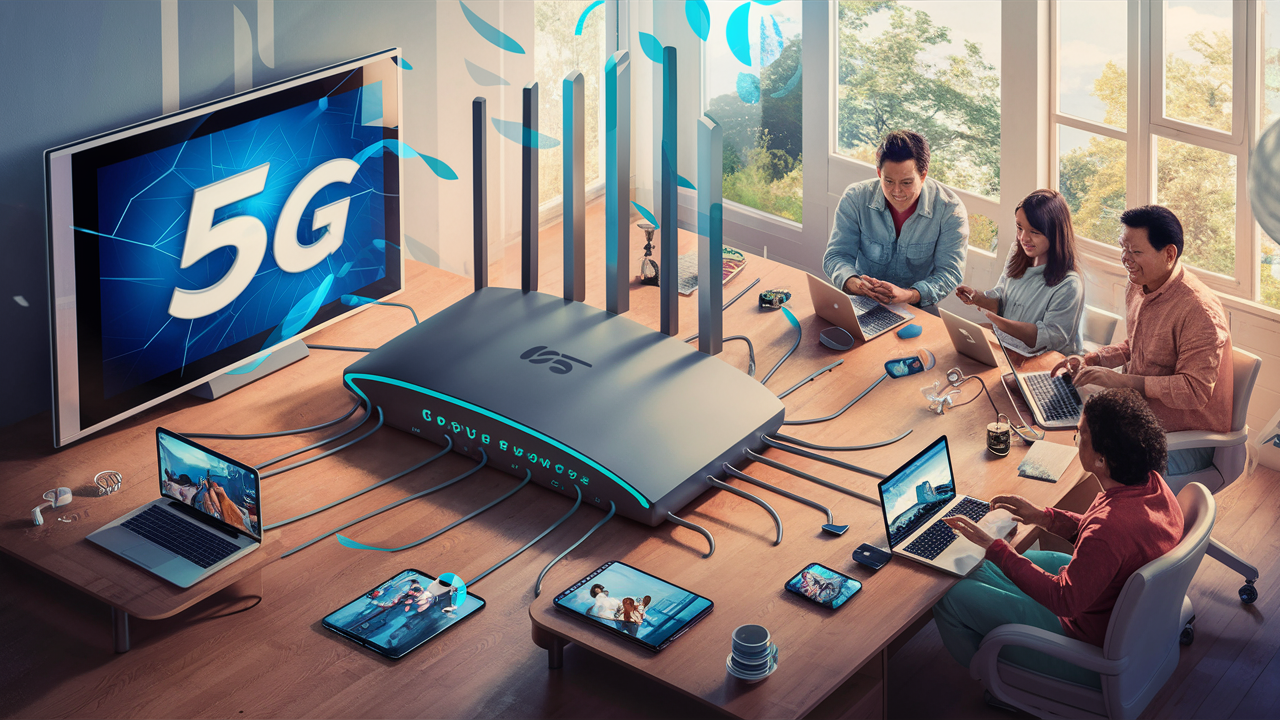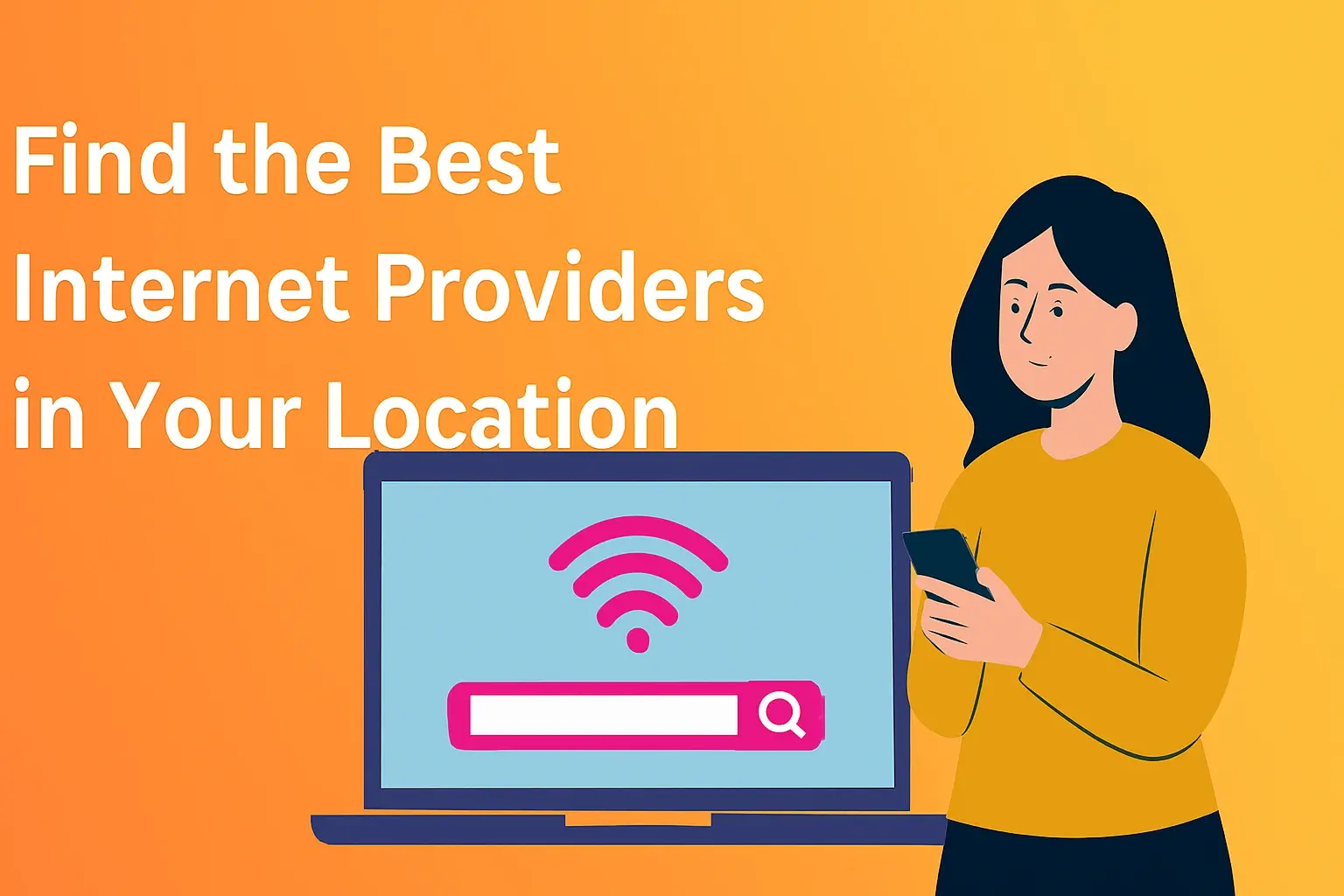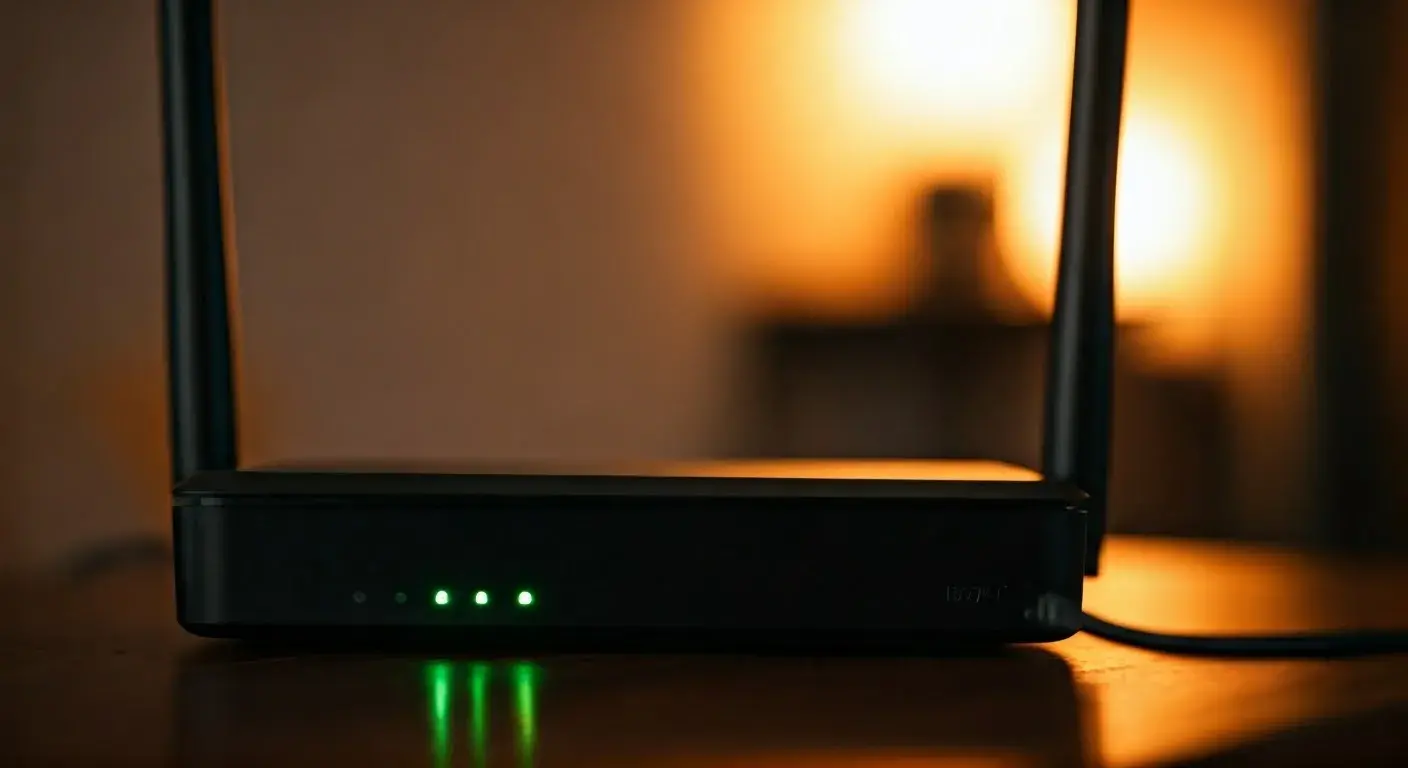Is 5G Good for Home Internet?

Wondering if 5G is the future of your home internet? This comprehensive guide dives deep into 5G home internet's capabilities, limitations, and whether it's the right fit for your household's needs in 2025. We'll explore speeds, reliability, costs, and compare it against traditional options.
What is 5G Home Internet?
5G home internet, also known as fixed wireless access (FWA) powered by 5G technology, represents a significant evolution in how broadband connectivity is delivered to residential properties. Unlike traditional wired connections like DSL, cable, or fiber optics, 5G home internet utilizes cellular networks to transmit data wirelessly directly to a receiver or gateway device within your home. This technology leverages the latest advancements in mobile network infrastructure, promising higher speeds, lower latency, and greater capacity than previous generations of wireless technology. In essence, it aims to bring the speed and responsiveness of mobile 5G to your stationary internet connection, offering a compelling alternative, especially in areas where wired infrastructure is limited or outdated. The goal is to provide a competitive and often more accessible broadband solution for a wide range of users, from casual browsers to heavy streamers and gamers.
How 5G Home Internet Works
Understanding the mechanics behind 5G home internet is crucial to appreciating its potential and limitations. At its core, 5G home internet is a fixed wireless access service. This means that instead of a physical cable running into your home, a signal is broadcast wirelessly from a nearby 5G cellular tower to a receiver or gateway device installed at your residence. This device then converts the wireless signal into a usable internet connection for your home network, typically via Wi-Fi.
The 5G Network Architecture
The 5G network is built upon a foundation of advanced radio frequencies and network architecture. It utilizes a spectrum of radio waves, including low-band, mid-band, and high-band (mmWave). Each band offers different characteristics:
- Low-band 5G: Offers wide coverage and good penetration through obstacles, similar to 4G LTE, but with slightly improved speeds.
- Mid-band 5G: Strikes a balance between speed and coverage, providing a significant performance boost over 4G and is often the backbone of many 5G home internet services.
- High-band (mmWave) 5G: Delivers extremely high speeds and low latency but has a limited range and is easily obstructed by buildings, trees, and even rain. While crucial for dense urban areas and specific applications, it's less common for broad home internet deployment due to its range limitations.
The Role of the 5G Gateway
The 5G gateway is the central piece of equipment for 5G home internet. It's typically a small, modern-looking device that connects to the 5G cellular network and then broadcasts a Wi-Fi signal throughout your home. Some gateways also include Ethernet ports, allowing you to connect devices directly via cable for a more stable connection. The gateway's placement is critical, as it needs a clear line of sight or minimal obstruction to the nearest 5G tower for optimal signal reception. Providers often offer guidance on optimal placement during installation.
Deployment and Infrastructure
The expansion of 5G home internet is intrinsically linked to the rollout of 5G cellular infrastructure. As carriers continue to build out their 5G networks, the availability and performance of 5G home internet services increase. This deployment involves installing new antennas on cell towers, upgrading existing infrastructure, and sometimes deploying smaller cell sites in urban areas to boost capacity and coverage, especially for mmWave frequencies. The ongoing investment in this infrastructure is what makes 5G home internet a growing and evolving option.
Data Transmission Process
When you request data (e.g., load a webpage), the request travels from your device to the 5G gateway, then wirelessly to the nearest 5G tower. From the tower, it enters the carrier's network and travels to the internet. The response follows the reverse path, returning to your device. The efficiency of this wireless transmission, coupled with the inherent speed of 5G technology, is what enables the potentially high download and upload speeds and low latency associated with 5G home internet.
The Advantages: Why 5G Home Internet Might Be Your Next Upgrade
5G home internet presents a compelling array of benefits that could make it an attractive alternative to traditional broadband services for many households. Its appeal lies in its potential for high speeds, flexibility, and accessibility. Let's delve into the key advantages:
1. Potentially High Speeds
One of the most significant draws of 5G home internet is its capacity for high download and upload speeds. While actual speeds vary greatly depending on the carrier, location, and specific 5G spectrum used, many providers advertise speeds comparable to or exceeding those of cable internet, and in some cases, approaching fiber optic speeds. In 2025, we're seeing average download speeds for 5G home internet ranging from 150 Mbps to over 1 Gbps in areas with robust mid-band or high-band 5G coverage. This makes it suitable for demanding activities such as:
- Streaming high-definition (4K/8K) video content without buffering.
- Simultaneous use by multiple devices and users in a household.
- Fast downloading of large files, software updates, and games.
- Smooth online gaming experiences.
For context, the average fixed broadband speed in the US in early 2025 is around 160-200 Mbps download. 5G home internet can often surpass this significantly, especially in well-covered areas.
2. Lower Latency
Latency, often referred to as ping, is the time it takes for data to travel from your device to a server and back. 5G technology is designed to offer significantly lower latency compared to 4G LTE and even some wired connections. In 2025, 5G home internet can achieve latencies as low as 10-20 milliseconds (ms), and sometimes even lower. This is a critical advantage for:
- Online Gaming: Low latency is paramount for competitive gaming, ensuring responsive gameplay and reducing lag.
- Video Conferencing: Smoother, more natural conversations with less delay.
- Real-time Applications: Such as remote work tools and interactive streaming.
While fiber optic connections generally offer the lowest latency, 5G is rapidly closing the gap, making it a viable option for latency-sensitive users.
3. Increased Accessibility and Availability
One of the most transformative aspects of 5G home internet is its potential to bridge the digital divide. In many rural, suburban, and even underserved urban areas, traditional broadband options like fiber or high-speed cable are either unavailable or prohibitively expensive to deploy. 5G home internet can be deployed much more rapidly and cost-effectively by leveraging existing cellular tower infrastructure. This means that households that have historically been limited to slow DSL or unreliable satellite internet may now have access to high-speed broadband. As 5G network buildouts continue in 2025, the geographic availability of 5G home internet is expanding significantly.
4. Simpler Installation and Portability
Compared to the installation of wired broadband services, which often require a technician to run cables to your home, 5G home internet installation can be considerably simpler. In many cases, you can receive a self-installation kit, which includes the 5G gateway. The setup process typically involves plugging in the device, placing it in a location with good signal reception (often guided by an app), and connecting your devices to the Wi-Fi network. This ease of setup can save time and potential installation fees. Furthermore, for those who move frequently, 5G home internet offers a degree of portability. If you move to an area where your provider offers 5G home internet, you can often take your service with you, avoiding the hassle of new installations and contract changes.
5. Competitive Pricing and Flexible Plans
As 5G home internet gains traction, providers are increasingly offering competitive pricing structures to attract customers. Many plans come with unlimited data, a significant advantage over older fixed wireless or mobile hotspot solutions that often impose strict data caps. Pricing in 2025 for 5G home internet typically ranges from $50 to $80 per month, often with introductory offers. Some providers are also offering more flexible plans, sometimes with no long-term contracts, which appeals to consumers seeking greater freedom and less commitment. This pricing can be particularly attractive when compared to the monthly costs of high-speed cable or fiber plans, especially in areas with limited competition.
6. Reduced Need for Physical Infrastructure
The reliance on wireless transmission means 5G home internet doesn't require extensive physical cabling to every home. This reduces the cost and complexity of deployment for providers, which can translate into more affordable services for consumers. It also means less disruption during installation. For areas where laying fiber optic cables is economically or logistically challenging, 5G FWA offers a viable and quicker path to high-speed internet access.
The Disadvantages: Potential Drawbacks to Consider
While 5G home internet offers exciting possibilities, it's not without its limitations. A realistic assessment requires understanding these potential drawbacks to make an informed decision. In 2025, these considerations are still relevant for many prospective users.
1. Variable Performance and Reliability
The biggest challenge for 5G home internet is its inherent variability. Unlike wired connections that are generally stable, wireless signals are susceptible to environmental factors and network congestion. Performance can fluctuate based on:
- Distance from the Tower: Signal strength diminishes with distance.
- Obstructions: Buildings, trees, hills, and even heavy rain can weaken or block the signal.
- Network Congestion: During peak hours, when many users are connected to the same cell tower, speeds can slow down. This is particularly true for mid-band and low-band 5G, which serve a larger area.
- Spectrum Used: High-band (mmWave) 5G offers the fastest speeds but has the shortest range and is easily blocked. Mid-band offers a good balance but still requires line-of-sight. Low-band offers better coverage but speeds are more modest.
This variability means that while you might experience gigabit speeds one moment, you could see a significant drop the next, especially if you're not in an ideal location relative to the tower. This inconsistency can be frustrating for users who rely on a stable connection for critical tasks.
2. Coverage Limitations
Despite rapid expansion, 5G network coverage is not yet ubiquitous. While major metropolitan areas often have extensive 5G networks, including mid-band and sometimes mmWave, rural and less populated areas may only have limited 4G LTE coverage, or perhaps only low-band 5G. This means that 5G home internet might not be available in your specific location, or if it is, it might be relying on lower-band frequencies that offer less impressive speeds. Providers typically have coverage maps on their websites, but these are often estimates, and actual performance can vary.
3. Data Caps and Throttling (Less Common, but Possible)
While many 5G home internet plans advertised in 2025 offer unlimited data, it's crucial to read the fine print. Some providers might still impose data caps, or implement "soft" data caps where speeds are significantly throttled after a certain usage threshold. This can be a major drawback for heavy users, such as large families who stream a lot of video, download large files regularly, or have multiple users online simultaneously. Always verify the data policy before signing up.
4. Equipment Costs and Installation
While self-installation is often an option, some providers may charge an upfront fee for the 5G gateway device. This cost can range from $100 to $300 or more, though some providers include it in the monthly service fee or offer it for free with a contract. If you need professional installation, this will also incur an additional cost. While generally less expensive than the installation of fiber optic lines, these equipment and installation costs can be a barrier for some.
5. Potential for Higher Latency Than Fiber
While 5G offers significantly lower latency than 4G LTE, it typically cannot match the ultra-low latency of fiber optic internet. Fiber optic connections are known for their near-instantaneous data transmission, often achieving latencies below 5 ms. For highly demanding applications like professional esports or critical industrial control systems, fiber may still be the superior choice. 5G's latency, while excellent for most consumer use cases, might still be a limiting factor for the most latency-sensitive professionals.
6. Dependence on Cellular Network Infrastructure
Your home internet service is directly tied to the performance and availability of the cellular carrier's 5G network. If the carrier experiences network outages or maintenance issues, your home internet will be affected. This is different from wired connections, where an outage might be localized to your street or neighborhood. A widespread cellular network issue could impact a much larger area, potentially leaving you without service.
7. Limited Bandwidth for Very High Demands
While 5G can offer speeds up to 1 Gbps or more, the actual bandwidth available to a single household can be limited by the tower's capacity and how many users are sharing it. In extremely dense areas with high demand, the shared nature of the wireless spectrum can lead to reduced speeds during peak times, even if the theoretical maximum is high. Fiber optic, on the other hand, provides a dedicated line to your home, meaning your bandwidth is not shared with neighbors in the same way.
5G Home Internet vs. Traditional Options
To truly understand if 5G home internet is a good fit, it's essential to compare it against the established broadband technologies available today. In 2025, the primary contenders are DSL, Cable, Fiber Optic, and Satellite internet. Each has its own strengths and weaknesses.
5G Home Internet vs. DSL
DSL (Digital Subscriber Line) uses existing telephone lines to deliver internet. It's widely available but generally offers the slowest speeds among wired options, typically ranging from 5 Mbps to 100 Mbps download, and often much less in rural areas. Latency can also be higher than 5G. 5G home internet is almost always superior in terms of speed and latency, making it a much more modern and capable solution for most users.
5G Home Internet vs. Cable Internet
Cable internet uses coaxial cables originally designed for cable TV. It offers speeds that are a significant step up from DSL, commonly ranging from 100 Mbps to over 1 Gbps download. It's widely available in most urban and suburban areas. The main drawback of cable is that its bandwidth is shared among users in a neighborhood, meaning speeds can fluctuate during peak usage times, though this has improved with DOCSIS 3.1 and 4.0 technologies. In terms of raw speed, 5G can compete with or even surpass cable, especially in well-covered areas. However, cable often offers more consistent performance and lower latency than 5G, particularly in areas with less robust 5G infrastructure or heavy cellular congestion. For most users, the choice between 5G and cable comes down to availability, specific pricing, and the consistency of performance in their particular location.
5G Home Internet vs. Fiber Optic Internet
Fiber optic internet is the current gold standard for home broadband. It uses strands of glass to transmit data as light signals, offering the fastest speeds (often symmetrical upload/download speeds of 1 Gbps or more), the lowest latency, and the most reliable connection. Fiber is less susceptible to interference and degradation. The primary limitation of fiber is its availability; it's expensive and time-consuming to deploy, meaning it's primarily found in newer developments or heavily invested urban areas. If fiber is available in your home, it is almost always the superior choice for speed, reliability, and latency. 5G home internet serves as an excellent alternative where fiber is not an option, offering speeds that can approach fiber's capabilities without the need for extensive physical infrastructure.
5G Home Internet vs. Satellite Internet
Satellite internet is often the only option for extremely remote or rural locations where wired broadband is impossible. It works by transmitting data to and from a satellite dish on your roof. However, satellite internet is known for its high latency (often 500 ms or more), slow speeds (typically 25-100 Mbps download), and strict data caps, making it unsuitable for most modern internet activities like streaming or gaming. 5G home internet is vastly superior to satellite internet in every measurable metric – speed, latency, and data allowances. For areas where 5G is available, it represents a monumental upgrade over satellite.
Comparison Table (Illustrative 2025 Averages)
| Feature | 5G Home Internet | Cable Internet | Fiber Optic Internet | DSL Internet | Satellite Internet |
|---|---|---|---|---|---|
| Typical Download Speed (Mbps) | 150 - 1000+ | 100 - 1000+ | 1000 - 10000+ | 5 - 100 | 25 - 100 |
| Typical Upload Speed (Mbps) | 20 - 100+ | 10 - 50+ | 1000 - 10000+ | 1 - 10 | 3 - 5 |
| Typical Latency (ms) | 10 - 50 | 10 - 30 | 1 - 10 | 20 - 80 | 500 - 700+ |
| Availability | Expanding rapidly, urban/suburban focus | Widespread urban/suburban | Limited, growing in new developments | Very widespread, including rural | Widespread, especially rural/remote |
| Reliability | Variable (weather, congestion) | Generally stable, some congestion | Very high | Generally stable, but slower | Variable (weather, satellite path) |
| Data Caps | Often unlimited, check provider | Rarely, but check provider | Very rarely | Rarely | Common, strict |
Key Factors to Consider Before Making the Switch
Deciding whether 5G home internet is the right choice for your household involves more than just looking at advertised speeds. A thorough evaluation of your specific needs and circumstances is crucial. Here are the key factors to consider in 2025:
1. Your Location and 5G Coverage
This is the single most important factor. Before you even consider signing up, use the provider's online coverage maps to check if 5G home internet is available at your exact address. Remember that these maps are often estimates. If possible, try to find real-world user reviews or talk to neighbors who are already using the service. Pay attention to the type of 5G spectrum available in your area (low-band, mid-band, or mmWave), as this will significantly impact speeds and reliability. For instance, if only low-band 5G is available, you might not see a significant improvement over 4G LTE.
2. Your Household's Internet Usage Habits
How do you and your family use the internet?
- Casual Browsing and Email: Most internet plans, including slower DSL or basic 5G, will suffice.
- Streaming (HD/4K): Requires consistent speeds of at least 25-50 Mbps for HD and 100+ Mbps for 4K. 5G can easily handle this if speeds are stable.
- Online Gaming: Demands low latency and stable, high speeds. 5G can be excellent, but fiber is superior for professional gamers.
- Multiple Users/Devices: A household with many people and devices online simultaneously needs higher bandwidth and capacity. 5G can struggle if the tower is congested or your signal is weak.
- Large File Downloads/Uploads: For professionals or heavy users, high upload and download speeds are essential.
3. Speed and Latency Requirements
Be realistic about the speeds and latency you actually need. While advertised speeds are attractive, consider your current internet plan and whether you're truly experiencing bottlenecks. If your current connection is adequate for your daily tasks, a switch to 5G might not be necessary unless you're seeking a significant upgrade or a more affordable option. However, if you're constantly frustrated by buffering, lag, or slow downloads, 5G could be a game-changer. For latency-sensitive activities like gaming or professional video conferencing, aim for plans that consistently offer sub-30ms ping times.
4. Data Caps and Usage Policies
As mentioned, many 5G home internet plans offer unlimited data, but it's imperative to verify this. Understand any potential data caps, fair usage policies, or speed throttling after a certain usage threshold. If your household consumes a large amount of data (e.g., multiple 4K streams per day, extensive cloud backups), a plan with strict data limits could be problematic. Compare the data policies of 5G providers with those of cable or fiber providers in your area.
5. Pricing and Contract Terms
Compare the monthly cost of 5G home internet plans with competing services. Factor in any upfront equipment costs, installation fees, and potential price increases after promotional periods. Also, examine the contract terms. Many 5G home internet plans offer month-to-month flexibility with no long-term contracts, which is a significant advantage for those who value flexibility or are unsure about the long-term performance. Traditional cable and fiber providers often require 1-2 year contracts.
6. Reliability and Stability in Your Area
This is where real-world experience is invaluable. While providers advertise peak speeds, the consistency of the connection is more important for daily use. If your area experiences frequent network congestion or has many physical obstructions, 5G performance might be unreliable. If possible, test the service for a month using a provider that offers a satisfaction guarantee or a trial period. Look for independent reviews specific to your neighborhood or city. A slightly slower but consistently stable connection is often preferable to a connection that promises high speeds but delivers them erratically.
7. Comparison with Local Alternatives
Always research all available options in your area. If you have access to fiber optic internet, it will likely remain the superior choice for performance and reliability. If cable is your only other high-speed option, compare its pricing, speeds, and reliability against 5G. In areas with limited competition, 5G can be a disruptive force, offering a much-needed alternative to slow DSL or expensive proprietary services. Don't assume 5G is automatically better; verify it against what's actually available to you.
The Verdict: Is 5G Good for Home Internet in 2025?
In 2025, the answer to "Is 5G good for home internet?" is a nuanced but increasingly positive one. For a significant and growing number of households, 5G home internet is not just good; it's an excellent, competitive, and often transformative broadband solution. Its primary strengths lie in its potential for high speeds, low latency, and broad accessibility, especially in areas underserved by traditional wired infrastructure.
If you live in an area with robust mid-band 5G coverage and have checked that your specific address is well-served, 5G home internet can offer speeds comparable to or exceeding many cable internet plans. This makes it ideal for streaming 4K content, online gaming, video conferencing, and supporting multiple connected devices simultaneously. The lower latency compared to 4G LTE and DSL is a significant advantage for real-time applications.
Furthermore, 5G home internet is a game-changer for those previously stuck with slow DSL, unreliable satellite, or no high-speed options at all. Its deployment is faster and less infrastructure-intensive than fiber, making it a more accessible upgrade for many. The often contract-free, unlimited data plans also add significant value and flexibility.
However, 5G home internet is not a universal solution. Its performance is still dependent on factors like signal strength, distance from the tower, and network congestion. If you are in an area with only weak low-band 5G coverage, or if your location is prone to signal obstructions, you might not experience the advertised speeds consistently. For the absolute best in speed, reliability, and latency, fiber optic internet remains the top tier, where available.
Our recommendation for 2025: If 5G home internet is available at your address and offers competitive speeds and pricing in your area, it is absolutely worth considering. It represents a modern, capable, and often more affordable alternative to traditional broadband. Always verify coverage at your specific location, understand your household's data needs, and compare plans carefully. For many, 5G home internet will prove to be a significant upgrade, delivering the high-speed, low-latency experience they need for modern digital life.





